This article needs additional citations for verification .(June 2021) |
Heroes of Might & Magic IV Collectible Card and Tile Game is a 2005 collectible card game created by DG Associates and designed by Jonathan Bjork. [1]
This article needs additional citations for verification .(June 2021) |
Heroes of Might & Magic IV Collectible Card and Tile Game is a 2005 collectible card game created by DG Associates and designed by Jonathan Bjork. [1]
The game is played on maps created at the start of the game from map tiles (world of Axeoth). [2] As the places on the tiles are too small to place the actual cards on, the locations of armies, objects, and towns are represented on the map as numbered and colored army, location, and town markers, respectively. Each marker to place on the map has an equivalent marker to place on the cards that the first represents. One is a color on white, the other is white on a color.
Map tiles use hexagon shapes with pictures to show the environment. They also add special extras to certain factions according to the advanced rules.
There are a variety of types of durable cards used throughout gameplay. They include creatures, spells, artifacts, towns, locations, and heroes.
Positions of cards on the map are represented by markers. Many reviews held the clumsiness of analyzing positions using markers as their only criticism of the game.
Each player searches through their deck for a starting army of 3 Level 1 creatures, 2 Level 2 creatures, and 1 Level 3 creature, as well as a hero, and a town to place on the side. All cards must be of the same alignment.
A random map tile is placed face up. Players then take turns selecting face-down map tiles and connecting them to the previous ones as they please.
Finally, players draw a hand, placing all but three of their hand face down into the "Adventure Stack," a pile from which cards can be played from, but not used as money from.
Up to six players can participate in this game.
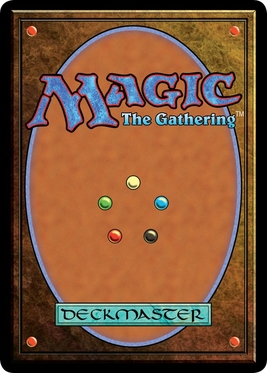
Magic: The Gathering is a tabletop and digital collectible card game created by Richard Garfield. Released in 1993 by Wizards of the Coast, Magic was the first trading card game and had approximately fifty million players as of February 2023. Over twenty billion Magic cards were produced in the period from 2008 to 2016, during which time it grew in popularity. As of the 2022 fiscal year, Magic generates over $1 billion in revenue annually.
Heroes of Might and Magic, known as Might & Magic Heroes since 2011, is a series of video games created and developed by Jon Van Caneghem through New World Computing.

Greyhawk Wars is a fantasy board wargame that was published by TSR, Inc. in 1991. The game was designed by David Cook as a strategic simulation of the eponymous Greyhawk Wars on the fictional world of Oerth, the World of Greyhawk campaign setting for the Dungeons & Dragons role-playing game.

Heroes of Might and Magic III: The Restoration of Erathia is a turn-based strategy game developed by Jon Van Caneghem through New World Computing originally released for Microsoft Windows by The 3DO Company in 1999. Its ports to several computer and console systems followed in 1999–2000. It is the third installment of the Heroes of Might and Magic series.

Killer Bunnies and the Quest for the Magic Carrot is a noncollectible card game created by Jeffrey Neil Bellinger and graphic design/illustrations by Jonathan Young. Other artists have contributed to the game, including early contributions by "Alex" Alexander, plus Matthew Holliday, Alex Julian, Harry Moore and Dave Montes.
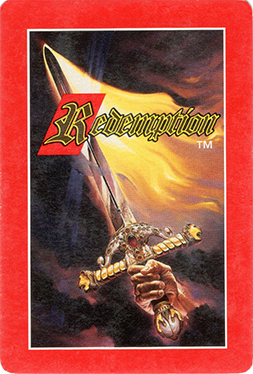
Redemption is a collectible card game based on the Bible. It involves Biblical characters, places, objects, and ideas. The object of the game is for players to use their Heroes to rescue Lost Souls by defeating their opponent's Evil Characters, with the first player to rescue five Lost Souls winning the game. Redemption was first published in July 1995 by Cactus Game Design and its creator, Rob Anderson, continues to develop and produce the game and is the final authority on rulings.
The collectible card game Magic: The Gathering published seven expansion sets from 1993–1995, and one compilation set. These sets contained new cards that "expanded" on the base sets of Magic with their own mechanical theme and setting; these new cards could be played on their own, or mixed in with decks created from cards in the base sets. With Magic's runaway success, many of the printings of these early sets were too small to satisfy the rapidly growing fanbase. Cards from them became rare, hard to find, and expensive. It was not until Fallen Empires and Homelands that Wizards of the Coast was able to print enough cards to meet demand; additionally, Wizards of the Coast published Chronicles, a reprint set that helped fix many of the scarcity issues with the earliest sets.

Dungeon! is an adventure board game designed by David R. Megarry and first released by TSR, Inc. in 1975. Additional contributions through multiple editions were made by Gary Gygax, Steve Winter, Jeff Grubb, Chris Dupuis and Michael Gray. Dungeon! simulates some aspects of the Dungeons & Dragons (D&D) role-playing game, which was released in 1974, although Megarry had a prototype of Dungeon! ready as early as 1972.
Card advantage is a term used in collectible card game strategy to describe the state of one player having access to more cards than another player, usually by drawing more cards through in-game effects to increase the size of their hand. Although it applies to several collectible card games, the concept was first described early in the evolution of Magic: The Gathering strategy, where many early decks relied on a player drawing more cards than their opponent, and then using this advantage to play more cards and advance their position faster than their opponent. By 2007 it was recognized as one of the most important indicators of who is ahead in a game and has been utilized in the development of strategy for nearly every collectible card game created.

Magic: The Gathering is a video game published by MicroProse in March 1997 based on the collectible card game Magic: The Gathering. It is often referred to as Shandalar after the plane of Shandalar, where the game takes place. The player must travel the land and fight random enemies to gain cards, and defeat five wizards representing the five colors. The player must prevent one color from gaining too much power, and defeat the planeswalker Arzakon, who has a deck of all five colors. Adventure and role-playing elements are present, including inventory, gold, towns, dungeons, random battles, and character progression in the form of new abilities and a higher life point total. An oversized version of Aswan Jaguar was included in the game box.

Chaotic is an out-of-print Danish collectible card game brought to the United States by Chaotic USA and 4Kids Entertainment, and distributed by TC Digital Games. It was released along with the open beta version of the online game on October 24, 2007. The card game is also featured in the animated series of the same name. As of 2014, the website is currently closed and the cards are no longer in production.
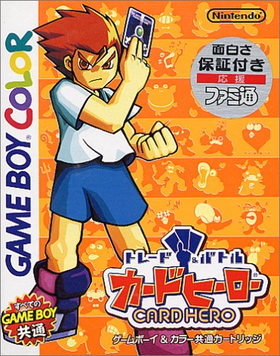
Trade & Battle: Card Hero is a card battle role-playing game developed by Nintendo and Intelligent Systems and published by Nintendo for the Game Boy Color. It was released in Japan on February 21, 2000. A sequel, Kousoku Card Battle: Card Hero, was released in 2007.
Ravnica is a Magic: The Gathering block that consists of three expert-level expansion sets: Ravnica: City of Guilds, Guildpact, and Dissension. Following in the tradition of other Magic blocks, Ravnica takes place in a plane of the multiverse that was previously unexplored in the game's backstory. The world of Ravnica is an ecumenopolis, a vast city that covers the entire surface of its planet, and is home to a diverse assortment of sentient races. Much power in Ravnica is held by the ten "guilds", political factions that each represent a combination of two of Magic's five colors. The mythology of Ravnica is loosely derived from Slavic folklore, and the character names reflect this. This plane was revisited in the Return to Ravnica block, and the Guilds of Ravnica,Ravnica Allegiance, War of the Spark, and Murders at Karlov Manor sets.
Android is an adventure board game designed by Kevin Wilson and Dan Clark, published in 2008 by Fantasy Flight Games. Set in a dystopian future, where the Moon is colonized and androids and clones are real, players take on the roles of murder investigators, investigating a murder within the fictional cities of New Angeles and Heinlein, a colony on the Moon. Players attempt to gain Victory Points by solving the murder, solving the conspiracy, and/or resolving the investigators' personal issues. The player with the most Victory Points wins the game.
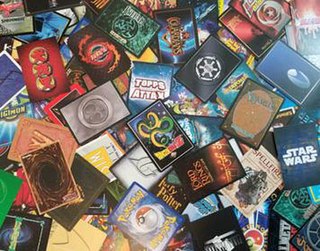
A collectible card game (CCG), also called a trading card game (TCG) among other names, is a type of card game that mixes strategic deck building elements with features of trading cards. It was introduced with Magic: The Gathering in 1993.

Heroscape is an expandable turn-based miniature wargaming system originally manufactured by Hasbro subsidiaries from 2004 until its discontinuation in November 2010. Geared towards younger players, the game is played using pre-painted miniature figures on a board made from interlocking hexagonal tiles, allowing for the construction of an interchangeable and variable 3D landscape. This system and the relatively high production quality of the game materials have been lauded by fans even years after the game was discontinued, eventually leading to its revival in 2024.
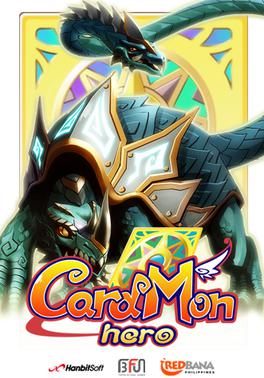
CardMon Hero is an anime-inspired free-to-play massively multiplayer online role-playing game (MMORPG) developed by Redbana and published by HanbitSoft. The game is unique in that players are able to command their primary avatar along with various mercenaries summoned via magical cards. Also, unlike most MMORPGs players, are not given classes to choose from but instead weapons which can be changed at any time and depending on which weapon is equipped decides what cards can be used. The game was released worldwide into open beta on January 19, 2011, and a full release has yet to be announced.

Magic: The Gathering – Puzzle Quest is a puzzle video game that combines the gem-matching concept in Puzzle Quest and its sequels, with the collectible card game aspects of Magic: The Gathering. It was released for mobile systems in December 2015.

Faeria is a digital collectible card and turn-based strategy game that takes place on a dynamic playing board set in a fantasy universe. The game was developed by Abrakam, and released for desktop platforms in 2017, for Xbox One and Nintendo Switch in August 2020 and for PlayStation 4 in November 2020. The game was well received by critics, holding a score of 80/100 on reviews aggregation website Metacritic.

Forbidden Desert is a cooperative board game developed by Matt Leacock and published by Gamewright Games. It is a sequel to the game Forbidden Island. It is also available on mobile.